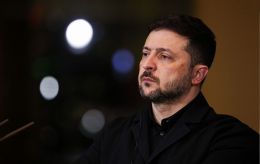Saving or printing money: Why West delaying assistance to Ukraine and what is government's plan B?
 U.S. President Joe Biden and Ukrainian Presidebt Volodymyr Zelenskyy (Phoro: Getty Images)
U.S. President Joe Biden and Ukrainian Presidebt Volodymyr Zelenskyy (Phoro: Getty Images)
As of now, Ukraine has not received guarantees from its partners regarding financial support for 2024. The issue of the final tranches for the current year is also unresolved. The government has a backup plan in case of delays with loans from the West, and its risks are outlined in the material by RBC-Ukraine.
During the preparation of the publication, materials from Bloomberg, statements by official representatives of Ukraine and the EU, interviews with officials and politicians on condition of anonymity, as well as comments from economists, were used.
With one month left until the end of the year, the government has not received about $6 billion to cover the budget deficit. However, there is still time to fill the gap in the state treasury. Another tranche of financial aid from the EU for 1.5 billion euros, from the IMF for $900 million, and from the US for $3.3 billion is expected. However, there are currently no guarantees of receiving these funds. For the EU tranche, Ukraine needs to adopt three laws , and funding from the US is currently blocked due to disputes in Congress. If the United States does not shed light on the funding situation, uncertainty will also affect the timing of the IMF tranche.
Nevertheless, even without these funds, the Cabinet of Ministers will manage to "close" the budget as much as possible without resorting to sequestration by redistributing funds, saving in some departments, and taking unplanned loans from other partner countries, according to a source familiar with the country's financial situation. Today, the tax authorities meet the established plan, but customs revenues may decrease due to issues with Polish carriers.
There are still many uncertainties and risks regarding the budget for the following year. To finance the deficit in 2024, over $41 billion will be needed. The main donors are the European Union and the United States, from which Ukraine expects 18 billion euros and $8.5 billion, respectively. There are currently no guarantees that these funds will arrive in full, and there are concerns that the amount of financial support may be reduced.
The EU is not yet ready to give more in 2024
According to the Ukraine Facility plan, the European Union is currently prepared to allocate only 8 billion euros. This plan is supposed to outline a four-year reform package – essentially conditions for financing, but it is not yet ready. Ukraine has sent its proposals to the European Commission, and in December, it expects a response from Brussels to finalize the document for approval by EU member states. The signing of the plan is expected in January.

Prime Minister of Ukraine Denys Shmyhal and Minister of Finance Sergii Marchenko (photo by Denys Smyhal)
Ukraine Facility will assist Ukraine in the amount of 50 billion euros over four years. Direct budget support from this amount will be 39 billion euros, with 8 billion euros going to the investment fund and 3 billion euros going to technical support.
The EU proposes evenly distributing the entire amount over four years, allocating 9.75 billion euros per year. The Ukrainian government has been negotiating for several months to increase the amount for the next year to 16-18 billion. Hungary is hindering the approval of the long-term EU budget, which allocates money to Ukraine, trying to unlock 13 billion euros for itself. This is part of the 22 billion euros frozen for Budapest in 2022 due to human rights and rule of law issues. The EU has already made concessions, and on November 23, it unfroze 900 million euros from this amount for Hungary.
However, the EU has found a way to resolve the situation. "We cannot be blackmailed... We can find a solution that involves only 26 member countries (of the European Union). There may be some delays if we have to take various measures. But yet, I am confident that we cannot be stopped," said EU Commissioner for Finance Johannes Hahn.
According to unofficial information, the decision will involve providing national guarantees from EU member states to attract market financing. However, the final amount for the next year has not yet been agreed upon.
The United States may reduce support.
The U.S. operates on a temporary budget until the beginning of 2024, which does not allocate funds for Ukraine. Recently, U.S. House of Representatives spokesperson Mike Johnson stated that assistance to Ukraine is a "priority," and funding should be allocated. "Certainly, we cannot allow Vladimir Putin to march across Europe. And we understand the need to provide assistance to Ukraine," Johnson said.

U.S. House of Representatives spokesperson Mike Johnson (photo by Getty Images)
Political analyst Volodymyr Fesenko believes this is good news for Ukraine. "If he (Johnson) says so, there are some agreements that the issue of supporting Ukraine will be considered in the lower house, and there is a principled agreement to support it," the political analyst said.
For now, Trumpists are willing to support funding for Ukraine in a package that includes an increase in the budget for border protection with Mexico, and the White House insists that it be a joint package with support for Israel. Fesenko believes a compromise can be reached, but there is a risk of reducing budgetary support for Ukraine. "Military aid will be preserved – a priority and direct budget support may be reduced. There is a risk," Fesenko believes.
Next year, Ukraine expects $8.5 billion from the United States for the budget. This amount may increase by $3.3 billion if not received this year. "At least, we would very much like it to be so – work is also being done on this issue," said Roksolana Pidlasa, Head of the Verkhovna Rada Budget Committee, in the interview with RBC-Ukraine.
Plan B – what it can be
In the face of uncertainty regarding financing in Ukraine, work is underway to prepare a Plan B. The first to publicly announce such a plan was the Governor of the NBU (National Bank of Ukraine), Andrii Pyshnyi, back in October during a meeting with IMF representatives.
"We need to develop our detailed Plan B to ensure the sustainability of the Extended Fund Facility program and maintain Ukraine's macro-financial stability under any conditions," said Pyshnyi. Government representatives are trying not to discuss publicly what this Plan B entails. "Talking about Plan B means signaling that we are abandoning Plan A," said one of the Servant of the People party deputies in a conversation with the agency.
If there is insufficient funding, the situation "will not please anyone," noted Pidlasa in an interview with RBC-Ukraine. She suggested that in this case, state programs that can be abandoned would be cut first, and there might be a redistribution of taxes from local budgets to the state.
But such measures are unlikely to be taken soon. Interlocutors familiar with the financial situation believe that it will be possible to survive at least the first quarter or even six months with a reduction in external funding without a sequester. And during this period, problems with financing can be resolved. In essence, this could be called the first stage of Plan B.
If financing issues cannot be resolved, the second stage – cutting programs and redistributing taxes – must be implemented. If this does not help the government stay "afloat," the "printing press" must be activated. Then, low inflation and a stable exchange rate will have to be forgotten. However, officials and economists RBC-Ukraine spoke with consider this option highly unlikely.
VitaliiVavryshchuk, Head of the Macro Research Department at ICU, sees no issues that cannot be resolved. "It seems that all partners are ready to continue providing financial support to Ukraine. However, there is a discussion about the amount of aid. Of course, the most challenging situation is with the United States, but here the question is rather when and what volumes of support Ukraine will receive, not whether it will receive it at all," noted Vavryshchuk.
According to him, the critical amount for Ukraine next year is $30 billion. This is needed for the NBU to maintain stability in the foreign exchange market without using reserves. For the budget, the required amount is over $40 billion. If it is not possible to attract this money to the funding from external sources, an alternative, according to Vavryshchuk, maybe the partial increase in the purchase of government bonds by banks and the resumption of the practice of NBU buying government bonds.
Oleksandr Paraschiy, Head of the Analytical Department at Concorde Capital, believes that formulating Plan B is complicated because Plan A is unrealistic. "The problem here is that our Plan A is systematically flawed. It is, let's say, constantly overfulfilled. Look at what is happening with revenues to the budget (revenues plus financing). A third of our revenues are unplanned. And further, obviously, it will be the same," he commented to RBC-Ukraine.
The actual financial result this year does differ from the plan. This would be a failure for the Ministry of Finance and the government in peacetime. However, unplanned revenues will precisely allow the ending of 2023 without shocks in the absence of expected external inflows.
The government is preparing Plan B as a last resort, but negotiations with partners are now continuing. Government insiders are confident that an agreement with the EU to increase funding for 2024 will be possible. Similarly, a positive result from the United States can be achieved.

